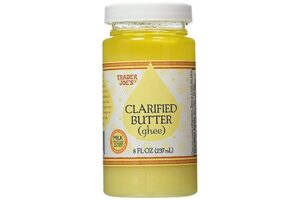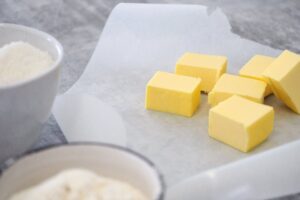Interested in learning the differences and similarities between clarified butter and drawn butter? If so, this article is for you!
Spoiler alert: They’re basically the same thing but with slight differences.

That being said, let’s compare the two regarding flavor, cooking temperature, and much more and see where they differ.
What is Clarified Butter?
Clarified butter is regular butter that has had the water and milk solids removed.
Therefore, it’s like the pure, golden, liquid part of butter without the stuff that can burn or make it go bad quickly. Great for cooking because it has a high smoke point!
What is Drawn Butter?
Drawn butter is just another name for clarified butter. It’s like the butter without the water and milk solids, making it perfect for dipping seafood or drizzling over things without worrying about it getting all funky.
Clarified Butter vs Drawn Butter: Cooking Temperature
Clarified butter and drawn butter aren’t so different, although some may disagree. They’re essentially the same butter with the water and milk solids removed.
Now, when it comes to cooking temperature, both have a higher smoke point compared to regular butter. This means you can heat them to a higher temperature before they start to break down and smoke up your kitchen.
The removal of water and milk solids in clarified or drawn butter gives it a more stable composition. This makes it suitable for sautéing and frying at higher temperatures without the risk of burning.
So, whether you call it clarified or drawn, you’re talking about a butter that can take the heat in the kitchen without turning into a smoky disaster!
Clarified Butter vs Drawn Butter: Flavor
When it comes to flavor, both clarified butter and drawn butter share a common essence—they’re like the pure, concentrated goodness of butter.
By removing the water and milk solids, you’re left with a rich, buttery flavor that’s more intense than regular butter.
Now, some might argue that there’s a subtle nuance between the two. Some say drawn butter, which often implies it’s been melted and served warm, might have a slightly different flavor due to the cooking process.
But in practical terms, the taste difference is minimal. So, whether you choose clarified or drawn, you’re in for a flavorful, buttery treat!
Clarified Butter vs Drawn Butter: Culinary Applications
In the kitchen, both clarified butter and drawn butter have their uses. Their primary superpower is the ability to handle higher temperatures without burning, thanks to the removal of water and milk solids.
You can use them for sautéing, frying, and searing because they won’t turn into a smokey mess.
Clarified or drawn butter is also fantastic for drizzling over dishes or dipping seafood, giving that pure, rich, buttery goodness without the risk of it getting all greasy.
So, whether you’re cooking up a storm or want to add a decadent touch to your meal, clarified and drawn butter has got your back in the kitchen!
Here’s a list of recipes where clarified or drawn butter can shine:
1. Sautéed Shrimp with Garlic Butter

- Heat clarified or drawn butter in a pan.
- Add minced garlic and sauté until fragrant.
- Toss in shrimp and cook until pink and opaque.
- Squeeze some lemon juice and sprinkle chopped parsley.
- Serve over pasta or with crusty bread.
2. Lemon Butter Sauce for Fish
- Melt clarified or drawn butter in a saucepan.
- Stir in fresh lemon juice and zest.
- Add a pinch of salt and pepper to taste.
- Pour over pan-seared or grilled fish fillets.
3. Vegetable Stir-Fry
- Use clarified butter for stir-frying a mix of colorful vegetables.
- Add soy sauce, ginger, and garlic for flavor.
- Serve over rice or noodles.
4. Lobster or Crab Dip
- Mix clarified or drawn butter with cream cheese, shredded crab or lobster meat, and seasonings.
- Bake until bubbly and serve with crackers or bread.
Remember, the key is to let that pure buttery goodness enhance the natural flavors of your ingredients!
Clarified Butter vs Drawn Butter: Appearance
In terms of appearance, clarified butter and drawn butter share a striking similarity. They’re both clear, golden liquid, free from the cloudy look that comes from milk solids in regular butter.
Picture a radiant pool of liquid sunshine—smooth, clear, and inviting.
Whether you call it clarified or drawn, the result is a visually appealing, golden elixir that’s not only pleasing to the eyes but also signals a butter that’s ready to elevate your culinary creations!
Clarified Butter vs Drawn Butter: Shelf Life
When it comes to shelf life, both clarified butter and drawn butter have a leg up on regular butter.
By removing the water and milk solids, you’re essentially saying goodbye to the elements that can make butter go rancid more quickly.
Clarified or drawn butter can last longer without refrigeration compared to regular butter. Stored in a cool, dark place, they can keep for several weeks, and in the fridge, they can hang on for a few months.
So, if you’re looking for butter that can stand the test of time, these clarified and drawn varieties are your kitchen shelf’s best friends!
Which is Better, Butter or Clarified Butter?

The choice between butter and clarified butter depends on what you’re using it for.
Butter
- Flavor: Butter is known for its rich, full-bodied flavor, thanks to the milk solids it contains.
- Versatility: It adds a creamy and distinct taste to both sweet and savory dishes.
- Use: Perfect for spreading on bread, baking, and dishes where you want that unmistakable buttery flavor.
- Downside: It has a lower smoke point due to the milk solids, so it’s not ideal for high-temperature cooking.
Clarified Butter
- Flavor: Clarified butter has a more concentrated buttery flavor as the milk solids are removed.
- Versatility: Excellent for high-heat cooking like sautéing and frying without the risk of burning.
- Use: Ideal for recipes where you want the butter flavor without the water content or milk solids, like making ghee or certain sauces.
- Downside: It lacks the nuanced flavor that the milk solids bring to traditional butter.
Which is better? It’s not a matter of one being definitively better than the other; it’s about what fits your culinary needs.
If you’re after the classic buttery taste and using it in baking or as a spread, go for butter. If you need stable fat for high-heat cooking without the risk of burning, clarified butter is your go-to.
In essence, they’re both stars in their own right, shining in different roles in the kitchen.
It’s like choosing between actors for different roles in a movie—sometimes you want the seasoned performer, and other times you need the specialist who excels in specific conditions.
Clarified Butter vs Drawn Butter: Conclusion
In conclusion, the choice between clarified butter and drawn butter depends on the culinary stage you’re setting.
Clarified butter takes the lead in high-heat performances, excelling in sautéing and frying with its concentrated buttery essence.
On the other hand, drawn butter adds a warm touch, perfect for drizzling over dishes. It’s not a rivalry; it’s a culinary collaboration, each playing a starring role in the kitchen.
So, whether you’re dancing with heat or seeking a buttery embrace, both clarified and drawn butter have their place on the gastronomic stage.
